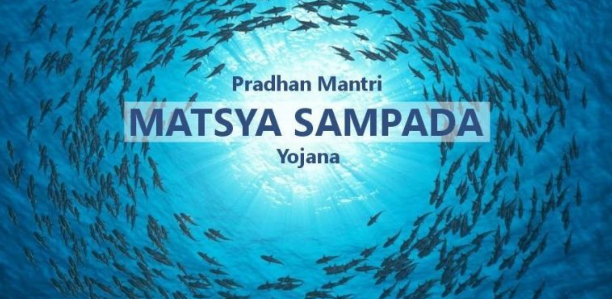Pradhan Mantri Matsya Sampada Yojana (PMMSY): Four Years of Progress (GS Paper 3, Economy)

Context:
- The Pradhan Mantri Matsya Sampada Yojana (PMMSY) has completed four years since its launch in 2020.
- This flagship scheme, implemented by the Department of Fisheries under the Ministry of Fisheries, Animal Husbandry, and Dairying, aims to accelerate the growth of India's fisheries sector, often referred to as the ‘sunrise’ sector.
Overview of PMMSY:
- Objective:
PMMSY seeks to provide momentum to the fisheries sector through integrated efforts combining various schemes and initiatives.
- It is designed to enhance fish production and productivity, improve infrastructure, and establish a robust regulatory framework for sustainable fisheries management.
Components of PMMSY:
- Central Sector Scheme (CS)
- Centrally Sponsored Scheme (CSS):
- Non-Beneficiary Oriented
- Beneficiary Oriented
- Enhancement of Production and Productivity
- Infrastructure and Post-Harvest Management
- Fisheries Management and Regulatory Framework
Fisheries Sector in India:
- Production & Export: India is the 3rd largest fish producer and 2nd largest aquaculture producer globally. It is also the 4th largest exporter of fish and fisheries products, with a 26.73% increase in exports between FY 2021-22 and FY 2022-23.
- Top Producing States: Andhra Pradesh leads in fish production, followed by West Bengal and Gujarat.
- Employment: The fisheries sector supports the livelihoods of over 30 million people in India.
Challenges Facing the Fisheries Sector:
- Overfishing: Excessive fishing pressure depletes fish stocks.
- Illegal, Unreported, and Unregulated (IUU) Fishing: IUU activities undermine conservation efforts and include unauthorized fishing and use of banned gear.
- Infrastructure Deficiencies: Inadequate facilities for storage and transport lead to post-harvest losses, while outdated technology affects productivity.
- Poor Fisheries Management: Inefficient enforcement and lack of comprehensive data exacerbate overfishing and illegal activities.
- Pollution and Habitat Destruction: Industrial pollution and coastal development threaten marine and freshwater habitats.
- Climate Change: Altered environmental conditions impact fish distribution and reproductive patterns.
- Socio-Economic Issues: Poverty and lack of alternative livelihoods make fishing communities vulnerable.
Government Initiatives:
- National Fisheries Development Board (NFDB): Established in 2006 to plan and promote fisheries development.
- Blue Revolution (2015): Focuses on sustainable development through modern technologies and enhanced infrastructure.
- Sagarmala Programme (2015): Aims at port-led development, including fisheries infrastructure.
- National Fisheries Policy (2020): Provides a framework for responsible management and conservation.
- Fish Farmers Development Agencies (FFDAs): Offer technical guidance and support to fish farmers.
- Fisheries and Aquaculture Infrastructure Development Fund (FIDF): Created with a fund size of Rs 7522.48 crore for infrastructure development.
- Coastal Aquaculture Authority (CAA): Regulates coastal aquaculture to ensure environmental conservation.
Future Directions:
- Strengthening Enforcement: Improve monitoring and enforcement to tackle IUU fishing.
- Financial Support: Provide incentives for adopting sustainable practices and modern technology.
- Habitat Protection: Focus on restoring and protecting aquatic habitats like mangroves and coral reefs.
- Supply Chain Improvement: Develop better infrastructure and market linkages to enhance market access and fair pricing.
Conclusion:
- PMMSY’s four-year journey reflects significant strides in developing India’s fisheries sector.
- Continued focus on overcoming existing challenges and implementing strategic measures will be crucial for sustaining growth and ensuring the sector’s long-term viability.


